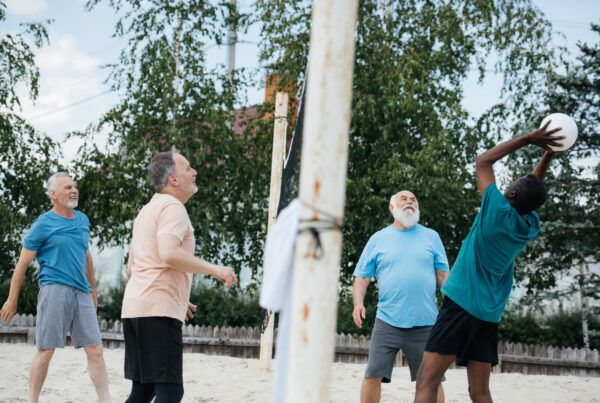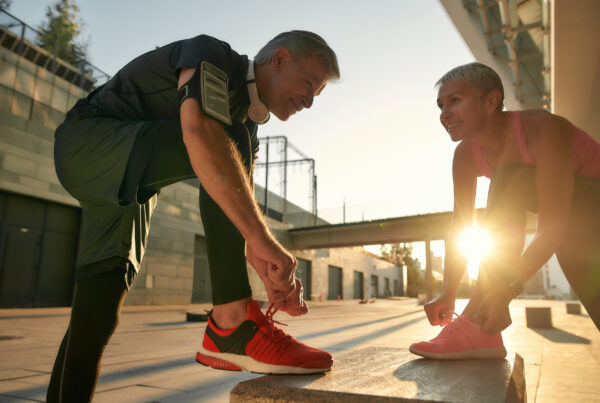”Question: What exercises can I do with my husband at home to get us both active?
Reading time: 10 Minutes
MWi Hacks:
- Find some great partner exercises to add to your daily routine
- Stay motivated at home by partnering up with a family member or friend for a workout
MWi Summary:
- It’s useful to keep these things in mind if you want to start doing partner workouts:
- Ideally, your partner has a similar strength level as you.
- Focus on form.
- Bodyweight is not the easiest option.
- We suggest choosing 5-7 exercises for a workout and complete 3 sets of 12 each.
- The exercises listed increase in difficulty as you go down the list.
21 Moves to Add to Your Partnered Workout Routine

If working out just sounds more fun with someone else, you’re in luck! Partnered workouts can provide a fun challenge and are easier to create than you may think.
Grab your significant other, bestie, or family member for a partnered workout routine and have some fun while breaking a sweat.
Read on for 21 moves we love.
Partnered workouts allow you to feed off of each other’s energy and work your muscles in a different way.
Before you begin, keep these things in mind:
- If possible, choose a partner with a similar strength level as you. This will make the exercises easier to execute properly, plus you’ll both get a great workout that way.
- Focus on form. Adding a partner into the mix can distract you. Make sure your form is still solid.
- Bodyweight isn’t the easiest option. It may seem counterintuitive, but bodyweight partner moves tend to be the most challenging. If you’re both beginners, start with a resistance band or medicine ball partnered workout.
How to build your routine.
If you need some partner workout ideas, look no further.
We’ve chosen a mix of exercises using bodyweight, a resistance band, and a medicine ball. The easier exercises in each section are listed first, and they gradually increase in difficulty.
Aim to choose at least 5 exercises for a workout — with a sweet spot around 7 — and complete 3 sets of 12 reps.
For the exercises where only one partner is doing the work, you should switch before moving on to the next exercise.
Remember to increase the resistance or weight once completing 12 reps feels easy. Continuing to challenge yourself is how you’ll progress.
If it’s just you and your partner and no equipment, no worries — body weight doesn’t mean easy! Do a 10-minute cardio warm-up before jumping in here.
1. Plank with a clap

Lift one hand off the ground and give your partner some skin while you plank.
To do this:
- Partner 1 and partner 2 should assume a high plank position, facing each other with about 2 feet between their hands.
- Both partners should pick up their right hand, lifting it to slap their partner’s, then returning it to the ground.
- Repeat with your left hands, and continue to alternate.
2. Leg lift

Use your partner as resistance for this ab work.
To do this:
- Partner 1 should lie on their back. Partner 2 should stand just behind partner 1’s head. Partner 1 should grab onto partner 2’s ankles.
- Partner 1 should complete a leg lift — recruiting their abs and keeping their back flat against the floor as they lift their legs off of the ground — stopping when they reach partner 2’s extended arms, then slowly lower back down.
3. Burpee

The exercise everyone loves to hate, burpees are made partner-friendly with a jump over.
To do this:
- Partner 1 should lie on the ground facedown.
- Partner 2 will perform a burpee, jumping over partner 1 instead of up in the air.
4. Pistol squat

Pistol squats are difficult, but using your partner as support will help you get there.
To do this:
- Partner 1 and 2 should stand facing each other, offset so their right shoulders align. They should join their right hands.
- Both partners should execute a pistol squat simultaneously, using each other as balance.
5. Pushup

Pushups in a wheelbarrow position are ratcheted up a notch.
To do this:
- Partner 1 should stand, and partner 2 should get on all fours in front, facing away.
- Partner 2 should place their feet in partner 1’s hands, walking out to a high plank position.
- Partner 2 should complete a pushup.
6. Hamstring curl

Use your partner for a hamstring curl, no machine required.
To do this:
- Both partners should kneel, partner 2 in front of partner 1.
- Partner 1 should place their hands-on partner 2’s ankles and kneel forward a bit, providing a counterbalance.
- Partner 2 should slowly fall forward from the knee up, focusing on the hamstrings on the way down. Place your hands down to catch yourself when you can’t hold anymore.
- Push back up to start and repeat.
7. Triceps dip

Target the back of your arms with a dip — and with the other partner doing a wall sit, they’ll still have to work, too.
To do this:
- Partner 1 should assume a wall sit against the wall.
- Partner 2 should execute a dip off of partner 1’s thighs: Place your hands, fingertips facing your butt, on partner 1’s thighs. Then, either bend your knees with feet flat on the ground or extend your legs with your heels on the ground. Dip by bending the elbows, then extending back up.
If you have a resistance band…
Resistance bands are a great way to strength train without a ton of impact. Choose a light or medium resistance to start, then work your way up. And again, start with a 10-minute cardio warm-up to get your muscles working.
8. Woodchop
Target the core and arms with a woodchop — partner-style.
To do this:
- Partner 1 should act as an anchor, holding the resistance band in front of them with both hands, and squat down.
- Partner 2 should grab the other handle and stand to the right side of partner 1, far enough away to make the resistance band taut. The band should be positioned at waist level on their left side.
- Partner 2 should pull the band across their body and up above their right ear with arms extended, twisting the core to the right as they go.
9. Row
One partner will anchor as the other rows.
To do this:
- Partner 1 should act as the anchor, grabbing the band in the middle and holding it in front of them with extended arms.
- Partner 2 should stand facing partner 1 and grab the handles, then back up until the band is taut and stagger your stance.
- Partner 2 should row, one arm at a time, by pulling their elbow to the back wall.
10. Chest press
Again here, one partner will anchor while the other chest presses.
To do this:
- Partner 1 should act as the anchor, grabbing the band in the middle and holding it in front of them with extended arms.
- Partner 2 should stand facing away from partner 1 and grab the handles, assuming a press position with the band underneath their arms and a staggered stance.
- Partner 2 should extend their arms and press the handles out, then back.
11. Triceps extension
Target the back of the arms one at a time with a little help from your partner.
To do this:
- Partner 1 should act as an anchor, grabbing the band by one handle and holding it in front of them.
- Partner 2 should face partner 1 and grab the other handle and hold the band taut, hinging at the waist until their body forms a 45-degree angle with the ground and pulling the band straight back until their arm is completely extended. Bend the elbow, then repeat.
- Complete the desired number of reps, then switch arms.
12. Lateral raise
Using your partner as an anchor, target your shoulders with a lateral raise.
To do this:
- Partner 1 should act as an anchor, stepping on the band near one handle with the handle near their left foot.
- Partner 2 should stand to partner 1’s right side and grab the other handle with their right hand.
- Partner 2 should execute a lateral raise, pulling the handle up and out to the side with their arm extended. Release back down and repeat.
13. Deadlift
Partner deadlifts with tons of weight can be dangerous. This resistance band variety is harder to mess up, still offering great benefits.
To do this:
- Partner 1 should act as an anchor, stepping on the band in the middle with both feet.
- Partner 2 should face partner 1, grab the handles, and stand up. Begin to deadlift, hinging forward at the waist while maintaining a proud chest and soft knees.
- Return to standing and repeat.
14. Rear delt fly
Targeting those posture muscles in the mid-upper back is great for everyday life. Choose a lightweight resistance band here to ensure you can execute properly.
To do this:
- Partner 1 should act as the anchor, stepping on the middle of the band with both feet.
- Partner 2 should stand facing partner 1 and grab the handles, hinging at the waist slightly.
- Keeping the arms extended, lift them out and away from the body, squeezing the shoulder blades at the top.
15. Woodchop
Another way to woodchop — using a medicine ball…
To do this:
- Partner 1 and partner 2 should stand side by side with the medicine ball in between.
- Partner 1 should squat and twist down to pick up the ball, then twist back up the other way, bringing the ball across the body and up over the opposite shoulder.
- Partner 1 should return the ball to start in the same movement. Partner 2 will then pick up the ball and repeat the same motion.
- Repeat for a desired number of reps, then switch positions.
16. Squat to overhead press
Compound exercises — those that work more than one muscle group at a time — are key for getting the most bang for your buck. Squat to overhead press is a great example.
To do this:
- Partner 1 and partner 2 should stand facing each other. Partner 1 should hold the medicine ball in front of their chest with both hands.
- Both partner 1 and partner 2 should squat down simultaneously, and on the ascent, partner 1 should press the ball overhead.
- Partner 2 will take the ball from partner 1 while it’s overhead, then both partners will squat back down and partner 2 will bring the ball to chest.
- Partner 1 and partner 2 will then push back up from the squat, while partner 2 will press the ball up and pass it to partner 1.
17. Pass around
Hit your core in a more untraditional way with this partner pass around.
To do this:
- Partner 1 and partner 2 should stand back to back. Partner 1 should hold the medicine ball in front of them.
- Keeping their feet planted, partner 1 should turn to the right and partner 2 should turn to the left, receiving the medicine ball from partner 1.
- Partner 2 should then turn to the right and partner 1 should turn to the left, receiving the medicine ball back from partner 2.
18. Lunge with toss
Hit your whole body with this lunge and toss.
To do this:
- Partner 1 and 2 should stand facing each other with about 3 feet in between. Partner 1 should hold the medicine ball.
- Partner 1 should lunge forward and toss the ball to partner 2 and stand back up.
- Partner 2 should catch the ball, lunge forward, and pass back to partner 1.
19. Situp
Make a situp more fun with a partner and a medicine ball.
To do this:
- Partner 1 and partner 2 should set up in a situp position, facing each other with toes touching. Partner 1 should hold the medicine ball at their chest.
- Both partners should execute a situp simultaneously, and partner 1 should pass the ball to partner 2.
- Both partners should return to the ground, do a situp again, and partner 2 should pass the ball back to partner 2.
20. Squat to chest press
Target your legs and upper body with a squat to chest press, another great compound exercise.
To do this:
- Partner 1 and partner 2 should stand facing each other with about a foot between. Partner 1 should hold the medicine ball at chest level.
- Both partners should squat down. On the ascent, partner 1 should press the ball straight out, passing it to partner 2.
- Both partners should squat down again, then partner 2 should press the ball out, passing back to partner 1.
21. Pushup
Medicine ball pushups aren’t for the faint of heart, so proceed with caution. Drop to your knees if a regular pushup is too challenging.
To do this:
- Both partners should get into a pushup position side by side. Partner 1 should start with the medicine ball under their outside hand.
- Partner 1 should do a pushup, push the ball to their inside hand, complete another pushup, then push the ball to partner 2’s inside hand.
- Partner 2 will complete a pushup here, push the ball to their outside hand, complete another pushup, then push the ball back to partner 1’s outside hand.
The bottom line
Partnered workouts — whether using bodyweight, resistance bands, or medicine balls — can provide a unique challenge. Motivate and push each other while still focusing on your own form.
More about the Expert:
Nicole Davis is a writer based in Madison, WI, a personal trainer, and a group fitness instructor whose goal is to help women live stronger, healthier, happier lives. When she’s not working out with her husband or chasing around her young daughter, she’s watching crime TV shows or making sourdough bread from scratch. Find her on Instagram for fitness tidbits, #momlife, and more.
https://www.instagram.com/nicole_l_davis/






